

Taping and/or an ankle brace may be used when returning to activities that require a change of support, especially for those with unstable ankles. Rehabilitation exercises are similar to that of a sprained ankle. Graded exposure to impact activities and return to play protocols if you wish to return to sport. This involves strengthening and mobility exercises of the foot and ankle. Upon removal of the boot, rehabilitation can last for 4-6 weeks. Historically a cast was used, but the walker boot allows for greater function and equivalent healing response.ĭuring this period, Physical Therapy can begin to maintain the mobility of the surrounding tissues, such as the Calf, Peroneal, and Posterior Tibialis muscles. Lateral Malleolus Fracture Conservative TreatmentĪ stable Lateral Malleolus Fracture is usually managed with 4-6 weeks in a walker boot. A study of 123 patients with lateral and mortise x-ray views are 95% accurate in diagnosing ankle fractures as anteroposterior, lateral and mortise views. An x-ray is the primary imaging model, but if this returns, as usual, a referral for an MRI or Ct Scan may be required. This is usually followed by imaging to rule out other conditions and to confirm the diagnosis. A clinical examination will often involve a hop test and tap test. Trauma such as impact to the ankle jointĪ consultation with a Physical Therapist, Podiatrist, or Sports Medicine Doctor is recommended if you have any of the symptoms of a Lateral Malleolus Fracture.Ī clinical interview of your symptoms alongside a clinical examination can often be sufficient to achieve a diagnosis for your therapist.Repetitive overload through impact activities such as running.Lateral Malleolus Fractures can be caused by a variety of factors, including: The syndesmosis attached the tibia and fibula together, this becomes torn or compromised with this type of fracture. Lateral Malleolus Fracture with syndesmotic disruption This is where the ligament is pulled off the bone and in doing so it can pull some flakes or fragments of the bone off with it. This is a type of fracture involving the growth plate and is common in children Flake or Avulsion Fracture This is when a gap appears in the bone at the site of the fracture and these often require surgical repair Epiphyseal Fracture Weber B fractures are generally stable fractures that can be managed conservatively with immobilisation and physical therapy. It can involve the ligaments attaching to the fibula and can be stable or unstable. This type of fracture occurs at the ankle level of the lateral malleolus and may extend up the fibula. Here are some of the most common types of Lateral Malleolus Fractures: Weber B Fracture

There are several types of Lateral Malleolus Fractures that can occur, ranging from stable to unstable fractures. However, it is important to note that some patients may not experience significant pain when walking due to low levels of body weight going through the lateral malleolus. Symptoms of a Lateral Malleolus Fracture include swelling and bruising over the lateral ankle, pain on weight-bearing, walking or hopping, pain when walking on uneven surfaces, and a protruding bone or malaligned foot in severe cases. The incidence rate of this injury appears to be similar between genders, but studies have found that it is more prevalent in females as they age. Lateral Malleolus Fracture Incidence RatesĪ study of 9767 patients with ankle fractures over a period of 9 years found that lateral malleolus fractures are the most common type of ankle fracture, accounting for 55% of all ankle fractures. Due to its position and role in weight-bearing, it is more commonly injured than the medial malleolus. It acts as a weight-bearing structure, absorbing approximately 10% of the weight in standing. The lateral malleolus is a bony prominence on the fibula that sits on the outside of the ankle joint. The talus is a small bone that sits on top of the heel bone, and it forms the lower part of the ankle joint. The fibula runs parallel to the tibia, on the outside of the leg. The tibia and fibula are long bones in the lower leg, with the tibia being the larger of the two. The ankle joint is comprised of three bones: the tibia, the fibula, and the talus. In this article, we will discuss the anatomy of the ankle joint, the various types of Lateral Malleolus Fractures, as well as the conservative and surgical treatment options available for this condition. These fractures are often caused by traumatic events such as falls or trips, but can also result from overuse injuries or poor biomechanics.

Lateral Malleolus Fractures are the most common type of ankle fracture, accounting for approximately 55% of all ankle fractures.


 0 kommentar(er)
0 kommentar(er)
